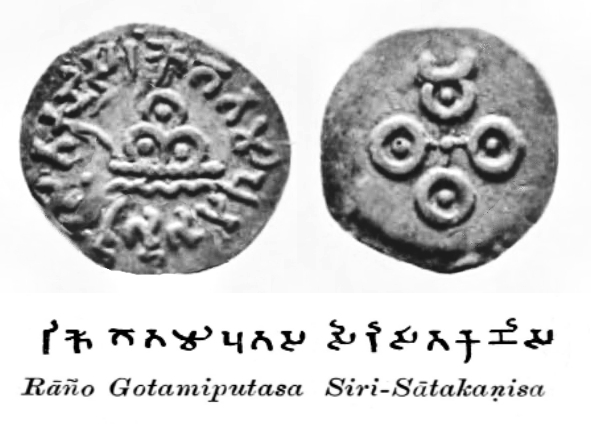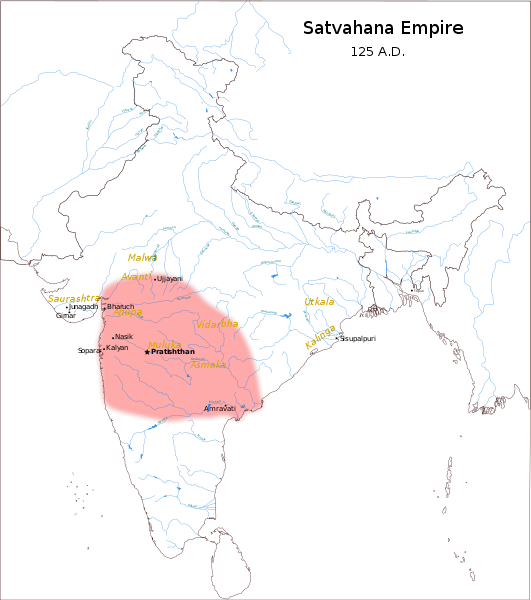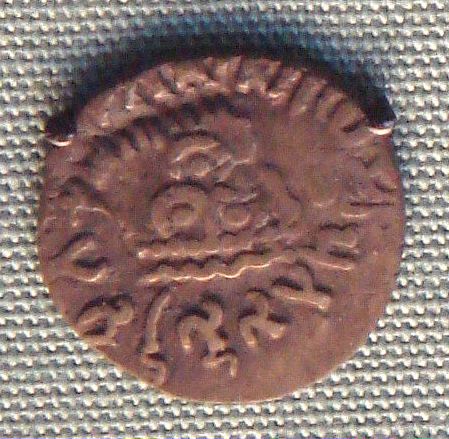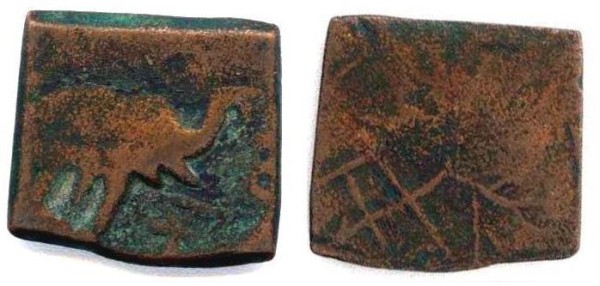
| GAUTAMIPUTRA SATKARNI Gautamiputra Satkarni was a ruler of the Shatvahan Empire in present-day Deccan region of India. He ruled in the 1st or 2nd century CE, although his exact period is uncertain. His reign is dated variously: 86-110 CE, c. 103-127 CE, 106-130 CE, or more recently and specifically ca. 60-85 CE.
The information available about Gautamiputra Satkarni comes from his coins, the Shatvahan inscriptions, and the royal genealogies in the various Purans. The best known of these is the Nashik prashasti (eulogy) inscription of his mother Gautami Balashri, which credits him with extensive military conquests. Historical evidence suggests that Gautamiputra revived the Shatvahan power after a decline caused by Shaka invasions.
Coinage of Gautamiputra Satakarni with Brahmi script legend "King Lord Satakarni, son of Gotami", starting at 12 o'clock. The decorative designs are the "Three-arched hill" and the "Ujain symbol". These coins were overstruck on silver coins of Nahapan.
Satavahana Ruler :
Ancestry
:
The mother of Gautamiputra Satkarni was Gautami Balashri, as attested by Nasik prashasti, an inscription found at Cave No. 3 of the Pandavleni Caves in Nashik. The inscription is dated to the 19th regnal year of his son Vasishthiputra Pulumavi (or Pulumayi). It records the grant of a village to the Buddhist monks of the Bhadrayaniya sect.
"Gautamiputra" literally means "son of Gautami", while Satkarni is a title common to several Shatvahan kings. Such matronymics also appear in the names of other Shatvahan kings, including Vasishthiputra Pulumavi ("Pulumavi, son of Vasishthi"). These do not indicate a matriarchy or a matrilineal descent system. The real explanation for matronymics seems to be that since the rulers married a number of wives from different royal families, a prince was best identified with reference to his mother.
Military
conquests :
Imperial extent according to Nashik prashasti :
Approximate extent of the Satavahana empire under Gautamiputra Satkarni, as suggested by the Nashik prashasti inscription. (John Keay, 2008) The Nashik prashasti inscription of Gautamiputra's mother, located in the Nasik Caves, calls him the "king of kings", and states that his orders were obeyed by the circle of all kings. It indicates that his rule extended from Malwa and Saurashtra in the north to Krishna river in the south; and from Konkan in the west to Vidarbh (Berar) in the east. It states that he ruled the following regions :
• Asik (area in Godavari valley)
The inscription also calls Gautamiputra the lord of following mountains :
•
Vindhyavat (part of Vindhyas)
The
"Nashik prashasti", inscription of Queen Gotami Balasiri
:
Full inscription of Queen Gotami Balasiri (rubbing)
The defeated "Saka-Yavan-Palhav" mentioned in the Nasik cave 3 inscription of Queen Gotami Balasiri (end of line 5 of the inscription)
"Success! In the nineteenth -19th- year of king Siri-Pulumayi
Vasithiputra, in the second -2nd- fortnight of summer, on the thirteenth
-13th- day, the great queen Gotami Balasiri, delighting in truth,
charity, patience and respect for life; bent on penance, self-control,
restraint and abstinence; fully working out the type of a royal
Rishi's wife; the mother of the king of kings, Siri-Satakani Gotamiputa.
Renunciation to the enjoyments of every kind."
— Nasik Caves inscription of Queen Gotami Balasiri, Cave No.3
An inscription at Karle records the grant of Karajik village (identified with a village in Pune district) by Gautamiputra, confirming that the Pune region was under his control.
The Nashik prashasti inscription further states that the horses of Gautamiputra drank waters of the "three oceans" (the Arabian Sea, the Bay of Bengal and the Indian Ocean). This implies that Gautamiputra subdued the Cholas and the Pandyas in southern India. However, there is no historical evidence of this. One view is that this is just a conventional literary device: Gautamiputra's empire was not as extensive as the inscription claims. Sudhakar Chattopadhyaya speculates that Gautamiputra might have raided some territories in the South.
According to American academic Carla M. Sinopoli, it is not clear if Gautamiputra actually had effective control over all the territories claimed as a part of his empire in the inscription. In any case, his military successes were short-lived.
Gautamiputra and Nahapan :
Caves excavated by Gautamiputra Satkarni as well as the Western Kshatrap king Nahapan are located at Nashik. The Nashik prashasti inscription states that Gautamiputra uprooted the Kshaharat (or Khagarat) family, to which Nahapan belonged. The Nashik inscription dated to the 18th year of Gautamiputra's reign states that he reaffirmed a grant of land to Buddhist monks living at the Trirasmi peak. This land was earlier in the possession of Nahapana's son-in-law Rishabhadatt (also known as Ushavadat), who had donated it to the monks.
A hoard of Nahapan's coins, discovered at Jogalthambi in Nashik district, includes coins re-struck by Gautamiputra. These coins feature an arched chaitya (Buddhist shrine) and the "Ujjain symbol" (a cross with four circles at the end).
Most historians now agree that Gautamiputra and Nahapana were contemporaries, and that Gautamiputra defeated Nahapana. M. K. Dhavalikar dates this event to c. 124 CE, which according to him, was the 18th regnal year of Gautamiputra. R.C.C. Fynes dates the event to sometime after 71 CE, in the same line, Shailendra Bhandare places the victory of Gautamiputra and the end of Nahapana's reign to the start of Saka era, 78 CE, in the year of Castan's accession, and considers Gautamiputra's whole reign to ca. 60-85 CE.
Coinage of Gautamiputra Satkarni :
A coin of Nahapana, re-struck by Gautamiputra Satkarni
A coin from Nashik
A silver coin, perhaps of Gautamiputra Satkarni (side 1)
A silver coin, perhaps of Gautamiputra Satkarni (side 2) Last years :
Cave No.3 at the Pandavleni Caves in Nashik was probably started during the reign of Gautamiputra Satkarni, and was finished and dedicated to the Buddhist Samgha during the reign of his son Vasishthiputra Pulumavi.
According to the Matsya Puran and the Vayu Puran, Gautamiputra ruled for 21 years. However, an inscription dated to his 24th regnal year has been found at the Nashik cave. The inscription mentions his mother as jiva-suta ("having a living son"). D. C. Sircar interpreted this to mean that the king was ill, and the term jiva-suta was intended to assure the people that the king was alive, while his mother ran the administration. Shailendra Nath Sen also speculated that the king might have been assisted by his mother in administration because of his illness or military preoccupation. V. V. Mirashi dismissed Sircar's theory as "ridiculous", arguing that jiva-suta is an expression used in several ancient sources and simply emphasizes the good fortune of a woman. Sudhakar Chattopadhyaya also criticizes Sircar's interpretation, pointing out that the first line in the inscription refers to the king's order. He adds that jiva-suta is simply an "affectionate expression of a mother", and should not be over-analyzed.
D. R. Bhandarkar and R. G. Bhandarkar believed that Gautamiputra and his son Vasishthiputra Pulumavi ruled jointly during the last years of his reign. This theory is based on their interpretations of the various Satavahana inscriptions. In Nashik prashasti, Gautami Balashri calls herself the mother of the great king as well as the grandmother of the great king, indicating that both were kings at that time. There are also indications that Gautamiputra was alive, when this inscription was issued in the 19th regnal year of his son. Despite this, the inscription describes the achievements of Gautamiputra Satkarni, but remains silent about the exploits of his son. Based on these arguments, Bhandarkar speculated that Gautamiputra ruled eastern Deccan, while Vasishthiputra ruled western Deccan. This theory has been dismissed by several other scholars, including K. A. Nilakanta Sastri and H. C. Raychaudhuri. G.J. Dubreuil theorizes that the excavation of the cave (where this inscription was found) began during the reign of Gautamiputra. However, the work was finished only after his death, and the inscription was placed on his behalf by his mother, during the reign of his son. Bhandarkar's theory is further weakened by the fact that there is clear historical evidence of Gautamiputra's rule over western Deccan. Moreover, no inscriptions issued jointly by the father-son duo are available.
It is possible that by the end of his reign, Gautamiputra lost some of his territory to the Kardamakas, a Western Kshatrap dynasty that succeeded Nahapana's Kshaharata dynasty. The Junagadh inscription of the Kardamak ruler Rudradaman I states that he defeated Satkarni, the lord of Dakshinpath (Deccan), twice. It also states that he spared the life of the defeated ruler because of close relations. "Satkarni" is a title common to several Shatvahan kings. According to D. R. Bhandarkar and Dineshchandra Sircar, the ruler defeated by Rudradaman was Gautamiputra Satkarni. However, E. J. Rapson believed that the defeated ruler was his son and successor Vasishthiputra Pulumavi. Shailendra Nath Sen and Charles Higham believe that the defeated ruler was Vashishtiputra's successor Shivaskanda or Shiva Sri Pulumayi (or Pulumavi).
Administration :
Gautami Putra Satkarni Statue in Amaravathi The location of Gautamiputra's capital is uncertain. In the Nashik inscription dated to his 18th regnal year, he is described as the "Lord of Benakataka". Carla M. Sinopoli identifies Benakataka as a place in the Nashik region. V. V. Mirashi identified it with Pauni Bhandara district.
The inscriptions of Gautamiputra Satkarni indicate that his empire was divided into units known as aharas. Each ahar was governed by an amatya or amaca. Three types of settlements are named in the inscriptions: nagar (city), nigam (town) and gam (village).
The Nashik prashasti inscription calls him ekbrahman. One interpretation of this word is "a peerless Brahmin" or "a staunch Brahmin", since the same inscription also states that he destroyed the haughtiness of the Kshatriyas. However, this term has also been interpreted differently as "the only protector of the Brahmins" or "a proud champion of Brahmanism". Nevertheless, the king also patronized Buddhist monks. According to one of his Nashik inscriptions, the monks were exempted from taxes and granted immunity from any interference by the royal officers.
The Nashik prashasti also states that the king's joys and sorrows were same as those of his citizens. It claims that he did not like to destroy life, even that of the enemies who offended him. The edict compares him to legendary heroes such as Ram, Keshav, Arjun, Bhimsen, Nabhag, Nahush, Janamejay, Sagar, Yayati and Ambarish.
Source :
https://en.wikipedia.org/wiki/ |
||||||||||||||||||||||||








_LACMA_M.84.110.3_(1_of_2).jpg)
_LACMA_M.84.110.3_(2_of_2).jpg)
.jpg)
